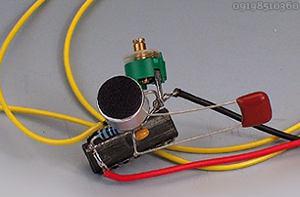میکروفن ساده اف ام


Although the idea has been around for a good while already, it’s still cute: a tiny circuit that you can hide just about anywhere for all sorts of eavesdropping activities. Fun for at work, but also usable as a babyphone. The basic necessities are a small micro-phone and a little transmitter. This can be realised using very simple resources.
This bug circuit operates in the normal VHF FM band and can thus be received using any ordinary radio. The schematic is based on a somewhat uncommon IC, the 74LS13, but with a bit of searching you can still manage to find one somewhere. The other five components (that’s all!) are all readily available. You might already have them in your parts drawer.
Here we use an electret capsule for the microphone. The necessary bias voltage is tapped off from the supply voltage via R1. If you use a crystal microphone instead, you can omit R1 and C3. The microphone signal is fed to pin 5 of the IC. C2 is included to slightly improve the performance and sensitivity of the circuit. C1 serves to decouple the supply voltage so any spikes that may be present are sup-pressed. Just about any short length of wire makes a suitable antenna.
FM Microbug Circuit Diagram:
The circuit operates on the third harmonic at around 100 MHz. It takes a bit of experimenting to find the right frequency on the radio, but within a range of a few metres the circuit can even overpower signals from relatively powerful transmitters. Of course, this circuit is not entirely legal, so you shouldn’t try to boost the power too much. A range of 20 metres is certainly possible with the circuit as shown.
This very simple circuit is highly sensitive and somewhat prone to positive feedback, especially if you hold it in your hand. The best approach is to put it down somewhere and stay away from it; then it works fine. If you want to experiment with the circuit, feel free!